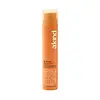What's inside
What's inside
 Key Ingredients
Key Ingredients

 Benefits
Benefits

 Concerns
Concerns

 Ingredients Side-by-side
Ingredients Side-by-side

Water
Skin ConditioningC12-15 Alkyl Benzoate
AntimicrobialDiethylamino Hydroxybenzoyl Hexyl Benzoate
UV FilterEthylhexyl Triazone
UV AbsorberBis-Ethylhexyloxyphenol Methoxyphenyl Triazine
Skin ConditioningPropanediol
SolventPhospholipids
Skin ConditioningPhenoxyethanol
PreservativeHydroxyacetophenone
AntioxidantNiacinamide
SmoothingPortulaca Oleracea Extract
Skin ConditioningPolypodium Polypodioides Extract
Skin ConditioningGlycerin
HumectantUrea
BufferingAlpha-Arbutin
AntioxidantAminopropyl Kojyl Phosphate
Skin Conditioning1,2-Hexanediol
Skin ConditioningSodium Hyaluronate
HumectantPotassium Hyaluronate
Skin ConditioningSodium Hyaluronate Crosspolymer
HumectantSodium Acetylated Hyaluronate
HumectantHydroxypropyltrimonium Hyaluronate
Hydrolyzed Hyaluronic Acid
HumectantHyaluronic Acid
HumectantHydrolyzed Sodium Hyaluronate
Skin ConditioningSodium Retinoyl Hyaluronate
Zinc Hydrolyzed Hyaluronate
HumectantAscorbylpropyl Hydrolyzed Hyaluronate
HumectantAscorbyl Propyl Hyaluronate
Skin ConditioningDimethylsilanol Hyaluronate
HumectantPentylene Glycol
Skin ConditioningButylene Glycol
HumectantSodium Benzoate
MaskingMethyl Methacrylate Crosspolymer
Potassium Sorbate
PreservativeTetrahydrodiferuloylmethane
AntioxidantAcrylates/C10-30 Alkyl Acrylate Crosspolymer
Emulsion StabilisingGlabridin
Bleaching4-Butylresorcinol
AntioxidantSodium Gluconate
Skin ConditioningWater, C12-15 Alkyl Benzoate, Diethylamino Hydroxybenzoyl Hexyl Benzoate, Ethylhexyl Triazone, Bis-Ethylhexyloxyphenol Methoxyphenyl Triazine, Propanediol, Phospholipids, Phenoxyethanol, Hydroxyacetophenone, Niacinamide, Portulaca Oleracea Extract, Polypodium Polypodioides Extract, Glycerin, Urea, Alpha-Arbutin, Aminopropyl Kojyl Phosphate, 1,2-Hexanediol, Sodium Hyaluronate, Potassium Hyaluronate, Sodium Hyaluronate Crosspolymer, Sodium Acetylated Hyaluronate, Hydroxypropyltrimonium Hyaluronate, Hydrolyzed Hyaluronic Acid, Hyaluronic Acid, Hydrolyzed Sodium Hyaluronate, Sodium Retinoyl Hyaluronate, Zinc Hydrolyzed Hyaluronate, Ascorbylpropyl Hydrolyzed Hyaluronate, Ascorbyl Propyl Hyaluronate, Dimethylsilanol Hyaluronate, Pentylene Glycol, Butylene Glycol, Sodium Benzoate, Methyl Methacrylate Crosspolymer, Potassium Sorbate, Tetrahydrodiferuloylmethane, Acrylates/C10-30 Alkyl Acrylate Crosspolymer, Glabridin, 4-Butylresorcinol, Sodium Gluconate
Cyclopentasiloxane
EmollientEthylhexyl Methoxycinnamate
UV AbsorberCaprylyl Methicone
Skin ConditioningDiethylamino Hydroxybenzoyl Hexyl Benzoate
UV FilterZinc Oxide
Cosmetic ColorantDicaprylyl Carbonate
EmollientTitanium Dioxide
Cosmetic ColorantDiethylhexyl Butamido Triazone
UV AbsorberNeopentyl Glycol Diheptanoate
EmollientSodium Hyaluronate
HumectantBis-Ethylhexyloxyphenol Methoxyphenyl Triazine
Skin ConditioningC12-15 Alkyl Benzoate
AntimicrobialPEG-12 Dimethicone
Skin ConditioningBrassica Campestris Seed Oil
Skin ConditioningGlycyrrhiza Glabra Root Extract
BleachingPolyglyceryl-3 Diisostearate
EmulsifyingAlthaea Officinalis Root Extract
Skin ConditioningOryza Sativa Bran Extract
Skin ConditioningHydroxymethoxyphenyl Decanone
Skin ConditioningHydrogenated Soy Polyglycerides
Skin ConditioningDiethylhexyl Syringylidenemalonate
Skin ProtectingTapioca Starch
Dimethicone/Vinyl Dimethicone Crosspolymer
Skin ConditioningGlyceryl Stearate
EmollientCaprylic/Capric Triglyceride
MaskingTriethoxycaprylylsilane
C15-23 Alkane
SolventPolymethylsilsesquioxane
Simethicone
EmollientAlumina
AbrasiveCyclopentasiloxane, Ethylhexyl Methoxycinnamate, Caprylyl Methicone, Diethylamino Hydroxybenzoyl Hexyl Benzoate, Zinc Oxide, Dicaprylyl Carbonate, Titanium Dioxide, Diethylhexyl Butamido Triazone, Neopentyl Glycol Diheptanoate, Sodium Hyaluronate, Bis-Ethylhexyloxyphenol Methoxyphenyl Triazine, C12-15 Alkyl Benzoate, PEG-12 Dimethicone, Brassica Campestris Seed Oil, Glycyrrhiza Glabra Root Extract, Polyglyceryl-3 Diisostearate, Althaea Officinalis Root Extract, Oryza Sativa Bran Extract, Hydroxymethoxyphenyl Decanone, Hydrogenated Soy Polyglycerides, Diethylhexyl Syringylidenemalonate, Tapioca Starch, Dimethicone/Vinyl Dimethicone Crosspolymer, Glyceryl Stearate, Caprylic/Capric Triglyceride, Triethoxycaprylylsilane, C15-23 Alkane, Polymethylsilsesquioxane, Simethicone, Alumina
 Reviews
Reviews

Ingredients Explained
These ingredients are found in both products.
Ingredients higher up in an ingredient list are typically present in a larger amount.
You might know this ingredient as Tinosorb S or Bemotrizinol. It is a UV filter that covers both UVA and UVB rays.
This ingredient has two peak UV absorption peaks ( 310 and 340 nm) and is able to absorb both UV-A and UV-B rays. This ingredient works by preventing UV rays from reaching and damaging your skin.
On top of that - it is highly photostable and helps prevent the photodegration of other sunscreen ingredients such as avobenzone.
Tinosorb S is allowed in the EU, Australia, and Asia. It is close to being approved by the FDA and we'll hopefully get this ingredient in the U.S. by late 2025.
Fun fact: Tinosorb S is the most effective UV absorber at maximum concentration (measured by SPF) permitted in the EU.
This ingredient is oil-soluble, so your oil-cleansers will take this right off at night.
Learn more about Bis-Ethylhexyloxyphenol Methoxyphenyl TriazineC12-15 Alkyl Benzoate is made up of Benzoic Acid and long chain alcohols. It has a low molecular weight.
C12-15 Alkyl Benzoate is an emollient and texture enhancer. Due to its solubility, it is often used in sunscreens to help evenly distribute active ingredients.
As an emollient, C12-15 Alkyl Benzoate helps soften and hydrate your skin. Emollients create a film on your skin that traps moisture within.
This ingredient has been reported to cause eye irritation.
Learn more about C12-15 Alkyl BenzoateDiethylamino Hydroxybenzoyl Hexyl Benzoate (DHHB) is a chemical UV-A absorber. It is formulated for high UVA protection (320-400 nm).
DHHB is well-liked for:
DHHB has been approved by the EU, Japan, Taiwan, and South America for use up to 10%. Unfortunately, it has not been approved for use in the US or Canada due to slow regulatory processes.
This ingredient is soluble in oils, fats, and lipids.
Learn more about Diethylamino Hydroxybenzoyl Hexyl BenzoateSodium Hyaluronate is hyaluronic acid's salt form. It is commonly derived from the sodium salt of hyaluronic acid.
Like hyaluronic acid, it is great at holding water and acts as a humectant. This makes it a great skin hydrating ingredient.
Sodium Hyaluronate is naturally occurring in our bodies and is mostly found in eye fluid and joints.
These are some other common types of Hyaluronic Acid:
Learn more about Sodium Hyaluronate